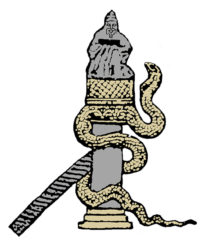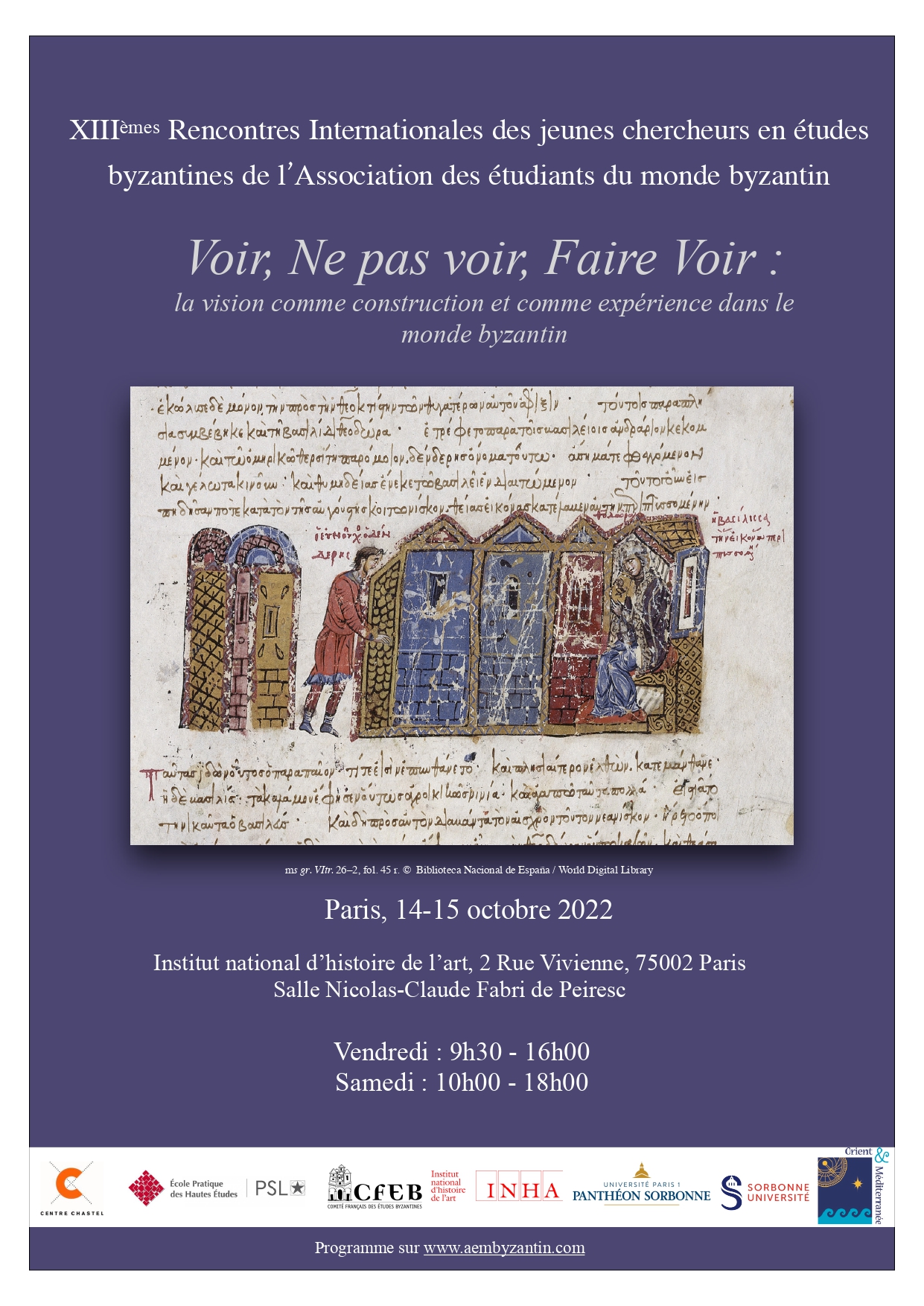14-15 octobre : les XIIIèmes Rencontres Internationales des jeunes chercheurs en études byzantines de l’AEMB
Cliquer ici pour télécharger le Programme des XIIIèmes rencontres de l’AEMB
Cliquer ici pour télécharger l’appel à communications
(English Version Below)
Pour la XIIIe édition des rencontres internationales des jeunes chercheurs de l’AEMB, le thème retenu, après consultation des membres de l’association, est la visualité.
Voir, Ne pas voir, Faire Voir : la vision comme construction et comme expérience dans le monde byzantin
Dans un épisode célèbre, rapporté notamment par Zonaras au XIIe siècle, le nain Denderis surprend l’impératrice Théodora en train, à l’insu de son époux, de vénérer les icônes. Interrogée par l’empereur, elle lui répond que Denderis s’est trompé et a vu dans un miroir le reflet de ses « belles poupées », dont il n’a pas su reconnaître la forme. Cet épisode met en jeu le regard et la perception, dans une dialectique qui fait appel au visible et à l’invisible : les icônes, indispensables au culte, convoquent la présence d’un Dieu dont la visibilité est rendue possible par l’Incarnation et, par conséquent, ces images saintes. Réservées aux seuls yeux de l’impératrice, elles sont, dans ce contexte iconoclaste, conservées loin des regards. Lorsque Théodora incrimine Denderis devant son époux, elle insinue que sa vision a été trompée, et résulte d’une mauvaise interprétation d’un reflet dans un miroir. Les différentes facettes de cette mise en scène littéraire du regard attestent du primat accordé à la vue, sens considéré par les Byzantins comme le premier, devant l’ouïe.
Le très riche vocabulaire grec de la vision lie plusieurs aspects de ce phénomène : d’une part sa dimension corporelle, puisqu’il s’agit d’un phénomène sensible mobilisant le corps du regardeur, auquel un rôle de projection ou de réception est donné selon que l’on privilégie la théorie de l’extramission ou celle de l’intromission, toutes deux débattues par les byzantins sans interruption, de l’Antiquité tardive à la période paléologue. Outil de connaissance, l’œil permet de saisir les phénomènes du monde visible ; il convoque discours scientifiques, médicaux, mais aussi moraux : la cécité peut être envisagée comme refus de Dieu. La privation de la vue est de surcroît un moyen de répression, fréquemment utilisé par les empereurs (et les impératrices) pour châtier leurs ennemis disgraciés et disqualifier les prétendants au pouvoir. C’est jusque dans la culture rhétorique que l’on retrouve cette prépondérance de la vision. Les auteurs jouent des effets de visualité pour guider le regard du lecteur, le procédé le plus célèbre étant l’ekphrasis, description visant à mettre devant les yeux l’objet ou l’événement évoqué.
Le rôle de la vision dans les phénomènes cognitifs est lui aussi affirmé, puisque l’empreinte dans l’esprit des choses vues sert ensuite à la mémorisation, à la conceptualisation, donnant lieu à de véritables images mentales qui peuvent être outils de connaissance. A cet égard, l’homélie prononcée par Photios à Sainte Sophie le 29 mars 867 est éloquente : l’auteur y associe étroitement la perception par la vue et la fixation d’un savoir dans la mémoire. Cette conceptualisation par les yeux de l’âme constitue en outre un moyen d’accéder à une vérité inaccessible par la seule perception du sensible, notamment le mystère divin. Ces images mentales prennent aussi la forme du rêve ou de l’illusion – thème fréquente dans les textes hagiographiques – dont la signification peut nécessiter un travail d’exégèse : ce dévoilement peut être injonction divine, ou avertissement au sujet de l’avenir, dont la forme la plus extrême est la vision apocalyptique.
Enfin, la dimension sociale et collective de la vision doit être prise en compte. Il n’y a qu’à se tourner vers le milieu impérial pour comprendre le rôle des cérémonies et de la mise en scène du pouvoir dans l’espace public. Cette incarnation du pouvoir concerne tout autant l’Église ; la place de la vision se pose de manière encore accrue dans les pratiques dévotionnelles et liturgiques, qui accordent aux images une fonction primordiale d’intercession, et unit la question de la visualité à celle du sacré, réservant certains rites à la vue du seul officiant. L’architecture, le décor monumental participent à la construction de l’expérience visuelle, en instaurant des limites à ce qui est visible ou non, en fonction du statut du regardeur et de sa position dans l’espace. Ce phénomène atteste le caractère socialement construit du regard, qui se concentre sur certaines figures et en marginalise d’autres.
C’est cette place centrale de la visualité dans l’épistémologie et la culture byzantines que les Rencontres internationales des jeunes chercheuses et chercheurs en études byzantines de 2022 souhaitent explorer.
Les communications, d’une durée de 20 minutes, pourront ainsi porter sur les thèmes suivants, sans s’y limiter :
- La conception scientifique de la vision
- Le rôle de la vision dans les processus cognitifs (mémorisation, images mentales, formation de concepts)
- La vision comme preuve et outil de connaissance
- Les procédés littéraires et picturaux stimulant la visualisation
- Les théophanies et les visions de personnes saintes
- La figuration de l’invisible
- Illusions, visions trompées, mauvaises visions
- La construction sociale du regard
- Les invisibles de la société byzantine
- La vision apocalyptique
- Espace, architecture et visibilité
- Vision comme outil de contrôle et de pouvoir
- La privation de la vision
- Les objets permettant la vision
- Les discours médicaux sur l’œil et la lumière
- Visions, rêves et interprétation
- Temporalité de la vision
- Lumière et obscurité
- La place de la vision dans la hiérarchie des sens
- Vision, spectacle et rituel
- Dissimulation et dévoilement
Les propositions de communications de 250 à 300 mots, ainsi qu’une brève biographie incluant l’institution de rattachement, le niveau d’études actuel (master, doctorat, post-doctorat) et le sujet de recherche devront être envoyées à aemb.paris@gmail.com au plus tard le 6 avril.
Les communications, d’une durée de vingt minutes, pourront être données en français ou en anglais. Nous espérons que les Rencontres se tiendront en présentiel, à Paris. La prise en charge des frais de transports par l’AEMB est possible pour les candidats ne pouvant obtenir de financement de la part de leur institution d’origine. Les candidats retenus devront adhérer à l’AEMB.
English Version :
For the 13th edition of the AEMB international post-graduate conference, the selected theme, chosen with consultation with members of the association, is Visuality.
Seeing, Not Seeing, and Being Seen: Vision as construction and as experience in the Byzantine World
In a well-known episode, reported notably by Zonaras in the 12th century, the dwarf Denderis surprises the empress Theodora while she is venerating icons, unbeknownst to her husband. When she is interrogated by the emperor, she responds to him saying that Denderis was mistaken, and that he saw the reflection of her “beautiful dolls” in the mirror, whose forms he did not recognize. This episode puts ideas of view and perception into play, in a dialectic that calls on the visible and the invisible: the icons, essential to the cult, invoke the presence of a God whose visibility is made possible through the Incarnation and, consequently, through these sacred images; reserved solely for the eyes of the empress, they are, in the iconoclast context, conserved out of sight. When Theodora incriminates Denderis in front of her husband, she insinuates that his vision was faulty, resulting in an incorrect interpretation of a reflection in the mirror. The different facets of this literary staging of vision attest to the importance accorded to sight, the predominant sense according to the Byzantines, before that of hearing.
The very rich Greek vocabulary pertaining to vision links several aspects of the phenomenon. First, there is a bodily dimension, since it is a sensory phenomenon which mobilizes the body of the viewer, to which a role of projection or reception is given depending on whether one favors the theory of extramission or that of intromission (both debated by the Byzantines without interruption from Late Antiquity to the Palaiologan period). A tool for knowledge, the eye makes it possible to grasp different phenomena of the visible world. It summons scientific, medical, and moral discourses: blindness can be considered as a refusal of God. Deprivation of sight is also a means of repression, frequently used by emperors (and empresses) to chastise their disgraced enemies and to disqualify pretenders to power. The role of vision is found even in rhetorical culture, where authors use visual effects to guide the reader’s gaze, the most famous process being that of ekphrasis, a description aimed at transporting the reader in front of the object or event that is being discussed.
The role of vision in cognitive phenomena is also affirmed, since the imprint in the mind of things seen can be used for memorization and for conceptualization, giving rise to mental images which can be tools for understanding. In this respect, the homily delivered by Photios at Hagia Sophia on March 29, 867 is compelling: the author closely associates perception by sight with the fixation of knowledge into memory. This conceptualization through the eyes of also constitutes a means of accessing an inaccessible truth, notably the divine mystery, through sensory perception. These mental images also take the form of dreams or illusions – a frequent theme in hagiographic texts – the understanding of which may require exegetical work: this unveiling may be a divine ordinance or a warning about the future, of which the most extreme form is the apocalyptic vision.
Finally, the social and collective dimension of vision must be taken into account. One need only look to the imperial milieu to understand the role of ceremonies and the staging of power in the public space. This incarnation of power equally concerns the Church; the place of vision arises in devotional and liturgical practices, which grant images a primordial function in intercession and which unite the concepts of visuality and the sacred, reserving certain rites for the sight of the celebrant alone. Architecture and monumental decoration participate in the construction of visual experience by establishing limits to what is visible or not, according to the status of the viewer and his position in space. This phenomenon attests to the socially constructed nature of the gaze, which focuses on certain figures and marginalizes others. It is this central role of visuality in Byzantine epistemology and culture that the 2022 international post-graduate conference in Byzantine Studies wishes to explore.
The 20 minute talks may therefore relate to, but are not limited to, the following topics:
- The scientific conception of sight
- The role of vision in cognitive processes (memorization, mental images, the formation of concepts)
- Vision as a tool for and proof of understanding
- Literary and pictorial techniques for stimulating vision
- Theophanies and visions of saintly people
- Figuring the invisible
- Illusions, deceiving visions, evil visions
- The social construction of the gaze
- Invisible parts of Byzantine society
- The apocalyptic vision
- Space, architecture, and visibility
- Vision as a device for power and control
- The deprivation of sight
- Objects which allow for sight
- Medical discourses on the eye or light
- Visions, dreams, and interpretations
- Temporality of vision
- Light and darkness
- The place of sight within the hierarchy of the senses
- Vision, spectacle, and ritual
- Concealing and revealing
Presentation proposals of 250 to 300 words as well as a brief biography including the author’s institution, their level of study (masters, doctoral, post-doctoral), and their research subjects should be sent to aemb.paris@gmail.com by April 6 at the latest.
The 20-minute talks may be presented in English or French.
It is our hope that the Rencontres will take place physically in Paris. Participants’ travel costs may be covered by AEMB if they are unable to receive funding from their institutions. Selected candidates will be asked to adhere to the association.


